人教版高一英语教学设计新部编版(1)
人教版高中英语新教材Unit 1 The Freshman Challenge教学设计
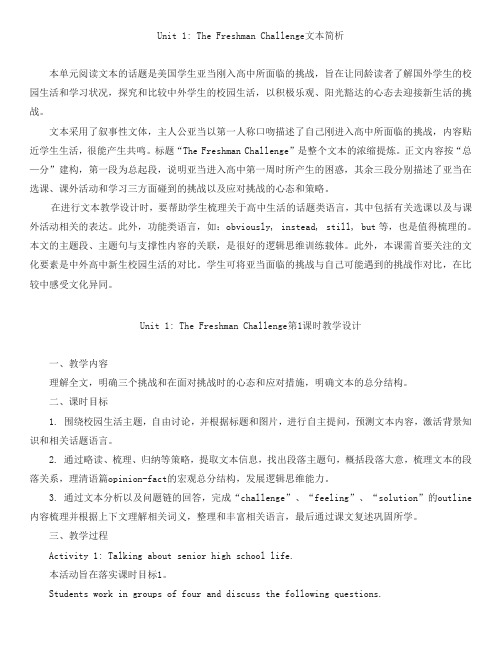
Unit 1: The Freshman Challenge文本简析本单元阅读文本的话题是美国学生亚当刚入高中所面临的挑战,旨在让同龄读者了解国外学生的校园生活和学习状况,探究和比较中外学生的校园生活,以积极乐观、阳光豁达的心态去迎接新生活的挑战。
文本采用了叙事性文体,主人公亚当以第一人称口吻描述了自己刚进入高中所面临的挑战,内容贴近学生生活,很能产生共鸣。
标题“The Freshman Challenge”是整个文本的浓缩提炼。
正文内容按“总—分”建构,第一段为总起段,说明亚当进入高中第一周时所产生的困惑,其余三段分别描述了亚当在选课、课外活动和学习三方面碰到的挑战以及应对挑战的心态和策略。
在进行文本教学设计时,要帮助学生梳理关于高中生活的话题类语言,其中包括有关选课以及与课外活动相关的表达。
此外,功能类语言,如:obviously, instead, still, but等,也是值得梳理的。
本文的主题段、主题句与支撑性内容的关联,是很好的逻辑思维训练载体。
此外,本课需首要关注的文化要素是中外高中新生校园生活的对比。
学生可将亚当面临的挑战与自己可能遇到的挑战作对比,在比较中感受文化异同。
Unit 1: The Freshman Challenge第1课时教学设计一、教学内容理解全文,明确三个挑战和在面对挑战时的心态和应对措施,明确文本的总分结构。
二、课时目标1. 围绕校园生活主题,自由讨论,并根据标题和图片,进行自主提问,预测文本内容,激活背景知识和相关话题语言。
2. 通过略读、梳理、归纳等策略,提取文本信息,找出段落主题句,概括段落大意,梳理文本的段落关系,理清语篇opinion-fact的宏观总分结构,发展逻辑思维能力。
3. 通过文本分析以及问题链的回答,完成“challenge”、“feeling”、“solution”的outline 内容梳理并根据上下文理解相关词义,整理和丰富相关语言,最后通过课文复述巩固所学。
新人教版高一英语必修一全册学案
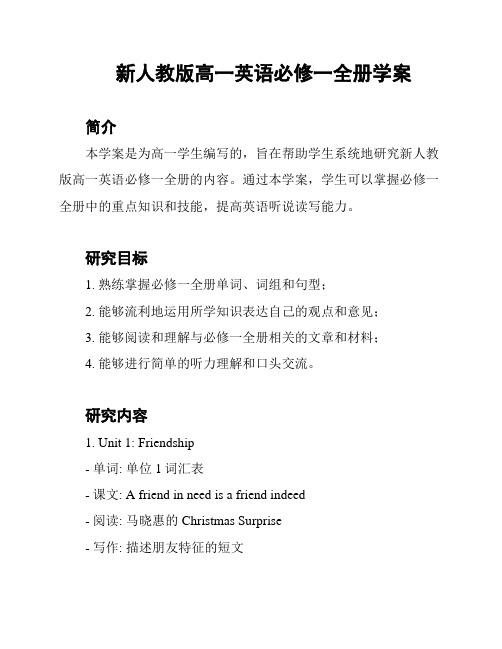
新人教版高一英语必修一全册学案简介本学案是为高一学生编写的,旨在帮助学生系统地研究新人教版高一英语必修一全册的内容。
通过本学案,学生可以掌握必修一全册中的重点知识和技能,提高英语听说读写能力。
研究目标1. 熟练掌握必修一全册单词、词组和句型;2. 能够流利地运用所学知识表达自己的观点和意见;3. 能够阅读和理解与必修一全册相关的文章和材料;4. 能够进行简单的听力理解和口头交流。
研究内容1. Unit 1: Friendship- 单词: 单位1词汇表- 课文: A friend in need is a friend indeed- 阅读: 马晓惠的Christmas Surprise- 写作: 描述朋友特征的短文2. Unit 2: English around the world- 单词: 单元2词汇表- 课文: English is widely spoken- 写作: 介绍英语在全球的使用情况3. Unit 3: Travel journal- 单词: 单元3词汇表- 课文: An exciting trip- 阅读: My unforgettable journey to Australia - 写作: 记叙一次令人难忘的旅行经历4. Unit 4: Music- 单词: 单元4词汇表- 课文: The universal language of music- 阅读: The power of music- 写作: 描述自己对音乐的热爱和体验5. Unit 5: Restaurants- 单词: 单元5词汇表- 课文: Eating out- 阅读: A memorable dining experience- 写作: 描述一次难忘的就餐体验研究活动1. 单词记忆:通过单词卡片、背诵等方式掌握单元中的新词汇和词组;2. 课文阅读:逐段阅读课文,理解文章的主旨和细节;3. 阅读理解:完成与课文相关的阅读理解题,提高阅读理解能力;4. 听力训练:听录音,完成听力题,提高听力理解能力;5. 口语练:与同学进行口语交流,练流利表达自己的观点;6. 写作训练:完成与课文相关的写作任务,提高写作能力;7. 复和测试:定期复所学内容,并进行测试,巩固知识。
高中英语新课标人教版教案必修一
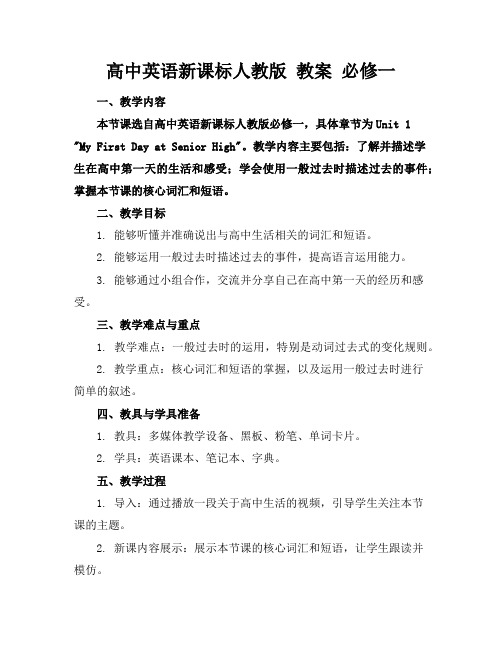
高中英语新课标人教版教案必修一一、教学内容本节课选自高中英语新课标人教版必修一,具体章节为Unit 1 "My First Day at Senior High"。
教学内容主要包括:了解并描述学生在高中第一天的生活和感受;学会使用一般过去时描述过去的事件;掌握本节课的核心词汇和短语。
二、教学目标1. 能够听懂并准确说出与高中生活相关的词汇和短语。
2. 能够运用一般过去时描述过去的事件,提高语言运用能力。
3. 能够通过小组合作,交流并分享自己在高中第一天的经历和感受。
三、教学难点与重点1. 教学难点:一般过去时的运用,特别是动词过去式的变化规则。
2. 教学重点:核心词汇和短语的掌握,以及运用一般过去时进行简单的叙述。
四、教具与学具准备1. 教具:多媒体教学设备、黑板、粉笔、单词卡片。
2. 学具:英语课本、笔记本、字典。
五、教学过程1. 导入:通过播放一段关于高中生活的视频,引导学生关注本节课的主题。
2. 新课内容展示:展示本节课的核心词汇和短语,让学生跟读并模仿。
3. 例题讲解:以"Yesterday was my first day at senior high. I"为例,讲解一般过去时的用法。
4. 随堂练习:让学生运用一般过去时,描述自己在高中第一天的经历。
5. 小组活动:学生分成小组,互相交流并分享自己的经历,提高语言表达能力。
六、板书设计1. 核心词汇和短语:写在黑板的左边,方便学生查看。
2. 一般过去时的结构:写在黑板的右边,突出教学重点。
七、作业设计1. 作业题目:请用一般过去时描述你昨天的一天。
2. 答案示例:Yesterday was my busy day. I got up at 6:00, had breakfast and went to school. In the morning, I had four classes. After lunch, I played basketball with my friends. In the evening, I did my homework and watched TV.八、课后反思及拓展延伸1. 课后反思:本节课学生对于一般过去时的掌握程度较好,但仍有个别学生动词过去式变化不准确,需加强练习。
新课标人教版高中英语必修一全部教学案
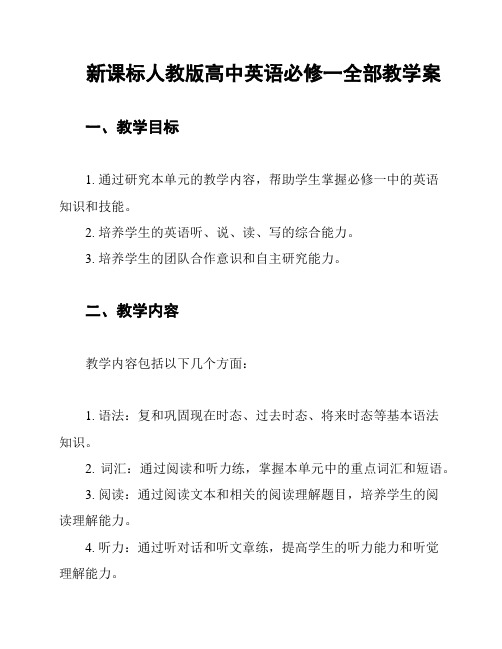
新课标人教版高中英语必修一全部教学案一、教学目标1. 通过研究本单元的教学内容,帮助学生掌握必修一中的英语知识和技能。
2. 培养学生的英语听、说、读、写的综合能力。
3. 培养学生的团队合作意识和自主研究能力。
二、教学内容教学内容包括以下几个方面:1. 语法:复和巩固现在时态、过去时态、将来时态等基本语法知识。
2. 词汇:通过阅读和听力练,掌握本单元中的重点词汇和短语。
3. 阅读:通过阅读文本和相关的阅读理解题目,培养学生的阅读理解能力。
4. 听力:通过听对话和听文章练,提高学生的听力能力和听觉理解能力。
5. 口语:通过各种口语练,提高学生的口语表达能力。
三、教学方法1. 任务型教学法:通过让学生完成一系列任务,激发学生的研究兴趣,加强学生的实际运用能力。
2. 合作研究法:引导学生在小组内进行合作研究,促进学生之间的互动和交流。
3. 归纳法:通过教师引导和学生参与,将教学内容进行总结和归纳,提高学生的研究效果。
四、教学步骤1. 导入:通过引入生活例子或相关资料,唤起学生对新学知识的兴趣。
2. 语法讲解:教师通过讲解和示范,介绍本单元的语法知识。
3. 词汇研究:通过词汇游戏和词汇练,帮助学生记忆和掌握本单元的重点词汇。
4. 阅读训练:教师通过指导学生阅读文本和做阅读理解题目,提高学生的阅读理解能力。
5. 听力训练:教师播放相关听力材料,学生进行听力训练和听觉理解练。
6. 口语练:教师引导学生进行口语练,提高学生的口语表达能力。
7. 总结归纳:教师对本节课的教学内容进行总结和归纳。
8. 作业布置:教师布置相应的作业,巩固学生对本节课的研究。
五、教学评价1. 教师根据学生的课堂表现、作业完成情况和考试成绩等,进行教学评价。
2. 学生之间进行互评,促进学生之间的交流和研究成长。
六、教学资源1. 教材:新课标人教版高中英语必修一教材。
2. 多媒体设备:投影仪、电脑、音响设备等。
3. 课外资料:相关的练册、参考书和教育软件等。
能够指导高一英语新人教版必修一Unit1课堂教学的教学计划
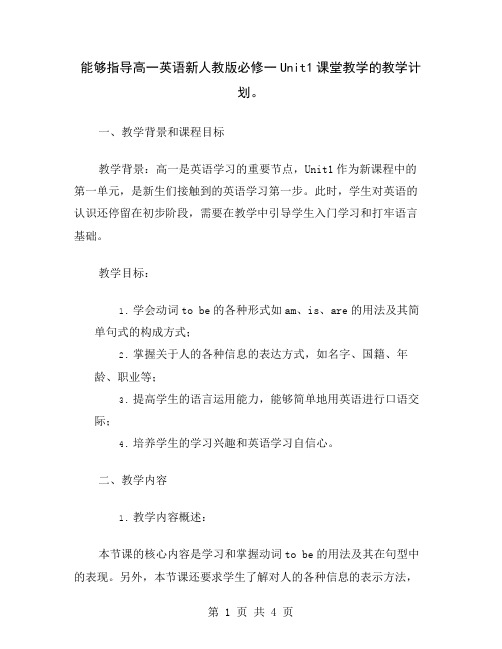
能够指导高一英语新人教版必修一Unit1课堂教学的教学计划。
一、教学背景和课程目标教学背景:高一是英语学习的重要节点,Unit1作为新课程中的第一单元,是新生们接触到的英语学习第一步。
此时,学生对英语的认识还停留在初步阶段,需要在教学中引导学生入门学习和打牢语言基础。
教学目标:1.学会动词to be的各种形式如am、is、are的用法及其简单句式的构成方式;2.掌握关于人的各种信息的表达方式,如名字、国籍、年龄、职业等;3.提高学生的语言运用能力,能够简单地用英语进行口语交际;4.培养学生的学习兴趣和英语学习自信心。
二、教学内容1.教学内容概述:本节课的核心内容是学习和掌握动词to be的用法及其在句型中的表现。
另外,本节课还要求学生了解对人的各种信息的表示方法,如名字、国籍、年龄、职业等。
在教学内容的安排上,我们将分为以下三部分进行:(1)介绍to be动词(2) to be动词在句型中的运用(3)自我介绍和对他人的介绍2.详细教学内容(1)介绍to be动词介绍to be动词时,教师要仔细讲解各种形式如am、is、are等在不同情境下的用法。
同时,建议老师在讲解时,可以借助图片或短视频等形式,让学生更加生动地理解to be动词的用法。
(2) to be动词在句型中的运用教师可以通过案例和练习来引导学生掌握各级别to be动词在简单句中的使用,同时,鼓励学生使用模板式的句型来练习。
建议教师在练习时,可以设定一些场景,让学生根据场景内容使用相应的to be 动词进行句子的构造,在运用中渐渐体会其中的语感。
(3)自我介绍和对他人的介绍这部分内容是教材中的重点内容,也是英语学习中必不可少的口语交际技能。
教师要针对学生的英语学习基础,灵活安排不同难度的任务。
对于刚开始学习英语的学生,教师可以提供完整的模板,让学生灵活替换其中的信息,使学生更好地理解语言表达的含义。
对于英语基础较好的学生,则可以引导学生自行撰写自我介绍内容,发挥自己的语言创造力。
2019新人教版英语必修一全册教案教学设计
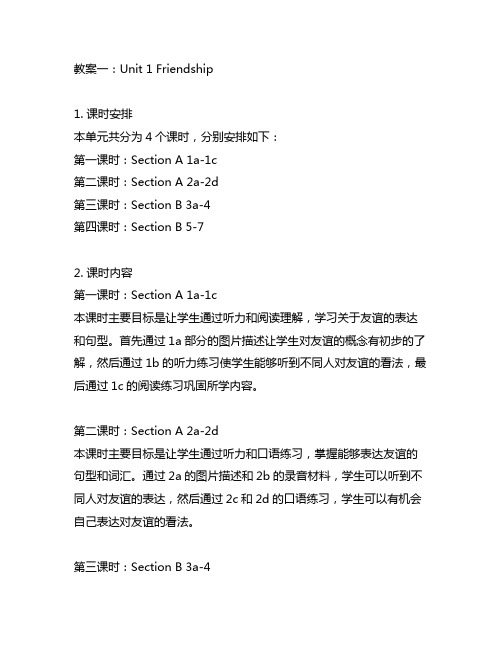
教案一:Unit 1 Friendship1. 课时安排本单元共分为4个课时,分别安排如下:第一课时:Section A 1a-1c第二课时:Section A 2a-2d第三课时:Section B 3a-4第四课时:Section B 5-72. 课时内容第一课时:Section A 1a-1c本课时主要目标是让学生通过听力和阅读理解,学习关于友谊的表达和句型。
首先通过1a部分的图片描述让学生对友谊的概念有初步的了解,然后通过1b的听力练习使学生能够听到不同人对友谊的看法,最后通过1c的阅读练习巩固所学内容。
第二课时:Section A 2a-2d本课时主要目标是让学生通过听力和口语练习,掌握能够表达友谊的句型和词汇。
通过2a的图片描述和2b的录音材料,学生可以听到不同人对友谊的表达,然后通过2c和2d的口语练习,学生可以有机会自己表达对友谊的看法。
第三课时:Section B 3a-4本课时主要目标是让学生通过听力和阅读理解,了解不同文化对友谊的看法。
通过3a和3b的录音材料,学生可以听到不同国家对友谊的表达,然后通过4的阅读练习,让学生更深入地了解不同文化对友谊的认识。
第四课时:Section B 5-7本课时主要目标是让学生通过听力和口语练习,掌握能够用英语表达友谊的能力。
通过5和6的听力材料,学生可以听到不同人对友谊的看法,然后通过7的口语练习,让学生能够自己用英语表达自己对友谊的看法。
3. 教学重点和难点本单元的教学重点是友谊的表达和句型,教学难点是如何让学生在实际生活中运用所学知识,进行口语交流。
4. 学情分析本单元学生的芳龄一般在14-16岁之间,他们对友谊这一主题可能会有一些自己的认识,但在英语表达方面可能还存在一定的困难。
因此在教学过程中需要及时发现学生的问题,并进行有针对性的辅导。
5. 教学方法本单元将主要采用任务型教学法,让学生通过实际的听力、阅读和口语练习来掌握所学内容。
(高一英语教案)高一英语新教材第一单元教学设计_高一英语教案

高一英语新教材第一单元教学设计_高一英语教案/Unit 1 Good Friends省前中供应Teaching Aims And Demands:1. Learn and master the following words and expressions:argue solution classicalsorrow survive share cast deserted adventure scared…be fond of in order tohunt for care about…2. Review direct speech and indirect speech3. Train the students’ ability of speaking.4. Train the students’ ability of reading comprehension.Teaching Important Points:1. Everyday English:1) Talk about friends2) Practice talking about likes and dislikes3) Learn to make apologies2. The correct understanding of the passage3. Grammar: direct speech and indirect speechTeaching Difficult Points:Train the students’ ability of reading comprehensionTeaching Methods:1. Explanation to make the Ss understand the difficult languages in the passage.2. Fast reading to find out the general information in the text.3. Question and answer to help the students go through with the whole passage.Teaching Aids:1. tape recorder2. multimediaTeaching ProceduresSection 1Step1. Lead-in ( warm up)It’s the first time for you to leave your family to live all alone. And everything around you are strange, the strange school, the strange classmates, the strange teachers and so on. Most of you do not getused to the life here, especially some girls, they maybe cry at night, they miss their father, mother, sisters, brothers …, because they feel alone.[1][2][3][4]下一页。
人教版高一英语必修一 教学设计
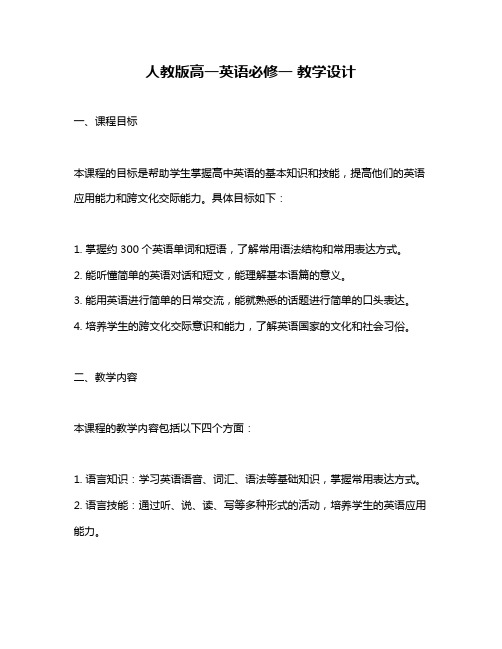
人教版高一英语必修一教学设计一、课程目标本课程的目标是帮助学生掌握高中英语的基本知识和技能,提高他们的英语应用能力和跨文化交际能力。
具体目标如下:1. 掌握约300个英语单词和短语,了解常用语法结构和常用表达方式。
2. 能听懂简单的英语对话和短文,能理解基本语篇的意义。
3. 能用英语进行简单的日常交流,能就熟悉的话题进行简单的口头表达。
4. 培养学生的跨文化交际意识和能力,了解英语国家的文化和社会习俗。
二、教学内容本课程的教学内容包括以下四个方面:1. 语言知识:学习英语语音、词汇、语法等基础知识,掌握常用表达方式。
2. 语言技能:通过听、说、读、写等多种形式的活动,培养学生的英语应用能力。
3. 跨文化交际:了解英语国家的文化和社会习俗,培养学生的跨文化交际意识和能力。
4. 学习策略:帮助学生掌握有效的学习方法和技巧,提高学习效率。
三、教学建议为确保教学效果,教师需要采取以下措施:1. 创造良好的语言环境:在课堂上尽可能使用英语进行教学和交流,营造良好的语言氛围。
2. 激发学生的学习兴趣:通过生动有趣的教学活动和多样化的教学手段,激发学生的学习兴趣和积极性。
3. 注重实践应用:在教学中注重学生的实践应用,通过对话、短文写作等方式提高学生的英语应用能力。
4. 培养学生的自主学习能力:引导学生自主学习,培养他们的独立思考和解决问题的能力。
5. 及时反馈和评价:对学生的表现及时给予反馈和评价,帮助他们发现问题并及时改进。
四、评价与反馈为了更好地评估学生的学习成果,需要制定评价标准和方法。
以下是一些建议:1. 平时成绩:根据学生的课堂表现、作业完成情况等平时成绩进行评价。
可以采用量化评价和质性评价相结合的方式。
2. 测验和考试:定期进行测验和考试,检查学生对所学知识的掌握情况。
考试形式可以多样化,如选择题、填空题、阅读理解等。
3. 口头表达:通过口头表达的形式,检查学生的口语表达能力。
可以安排学生分组进行对话练习或个人演讲等活动。
新人教版英语必修一教案设计

新人教版英语必修一教案设计教案标题:《新人教版英语必修一教案设计》教学目标:1. 了解和掌握必修一教材中的英语知识点和语法规则。
2. 培养学生的英语听、说、读、写能力,提高他们的综合语言运用能力。
3. 培养学生的跨文化交际能力,增强他们的跨文化意识。
教学重点:1. 英语基础知识和语法规则的掌握。
2. 听、说、读、写能力的培养和提高。
教学难点:1. 英语语法规则的理解和运用。
2. 跨文化交际能力的培养。
教学准备:1. 教材:《新人教版英语必修一》。
2. 多媒体设备:投影仪、电脑等。
3. 教学辅助工具:教学PPT、录音机等。
教学过程:一、导入(5分钟)1. 利用图片或视频引发学生对主题的兴趣。
2. 提问学生关于主题的问题,激发学生的思考。
二、学习目标呈现(10分钟)1. 利用多媒体展示学习目标,并与学生一起讨论目标的重要性和实际应用。
2. 解释本节课的重点和难点,并告知学生将要学习的知识点。
三、知识讲解与学习(30分钟)1. 分段教授本节课的知识点,通过示范和解释帮助学生理解。
2. 引导学生进行课堂互动,提出问题并让学生回答。
3. 组织学生进行小组活动或合作讨论,加深对知识点的理解和运用。
四、练习与巩固(20分钟)1. 分发练习册或作业本,让学生进行课堂练习。
2. 布置课后作业,巩固学生对本节课知识点的掌握。
五、跨文化交际(15分钟)1. 利用图片、视频等展示不同文化背景下的交际场景,引发学生对跨文化交际的兴趣。
2. 分组讨论跨文化交际中可能出现的问题,并提出解决方案。
六、课堂总结与反馈(10分钟)1. 回顾本节课的学习内容,总结重点和难点。
2. 鼓励学生提出问题和意见,并进行解答和反馈。
七、课后延伸(自主学习)(自定时间)1. 布置相关的课后阅读和练习,鼓励学生在课外进行自主学习。
2. 提供相关学习资源,如网站链接、推荐书籍等。
教学资源:1. 《新人教版英语必修一》教材及课后练习册。
2. 多媒体设备和教学辅助工具。
人教版高一英语必修一教学设计
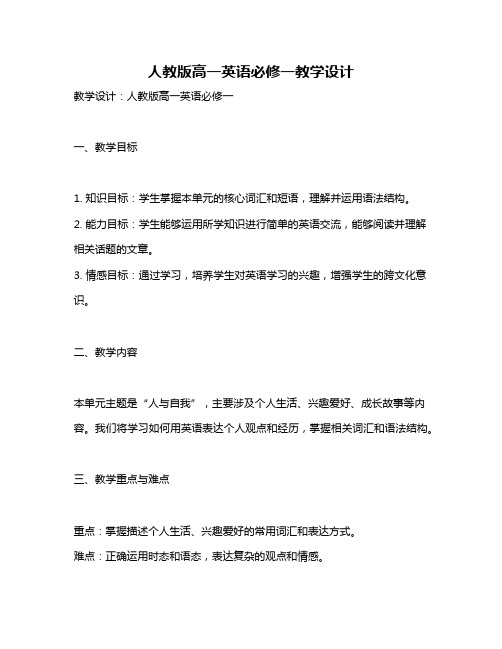
人教版高一英语必修一教学设计
教学设计:人教版高一英语必修一
一、教学目标
1. 知识目标:学生掌握本单元的核心词汇和短语,理解并运用语法结构。
2. 能力目标:学生能够运用所学知识进行简单的英语交流,能够阅读并理解相关话题的文章。
3. 情感目标:通过学习,培养学生对英语学习的兴趣,增强学生的跨文化意识。
二、教学内容
本单元主题是“人与自我”,主要涉及个人生活、兴趣爱好、成长故事等内容。
我们将学习如何用英语表达个人观点和经历,掌握相关词汇和语法结构。
三、教学重点与难点
重点:掌握描述个人生活、兴趣爱好的常用词汇和表达方式。
难点:正确运用时态和语态,表达复杂的观点和情感。
四、教学步骤
1. 导入(5分钟)
通过提问学生日常生活、兴趣爱好等话题,引导学生进入本单元主题。
2. 新课学习(30分钟)
通过讲解、示范、小组讨论等方式,学习本单元的词汇、语法和表达方式。
3. 练习与巩固(20分钟)
通过小组活动、角色扮演等形式,让学生在实际语境中运用所学知识,巩固所学内容。
4. 总结与反馈(10分钟)
对本节课所学内容进行总结,同时收集学生的反馈意见,以便改进教学方法。
五、教学评价与反思
通过观察学生在课堂上的表现,评估学生对本单元内容的掌握情况。
同时,反思自己的教学方法和效果,不断完善和提高教学质量。
2019统编人教版高中英语必修第一册unit 1《Teenage life》全单元教案教学设计
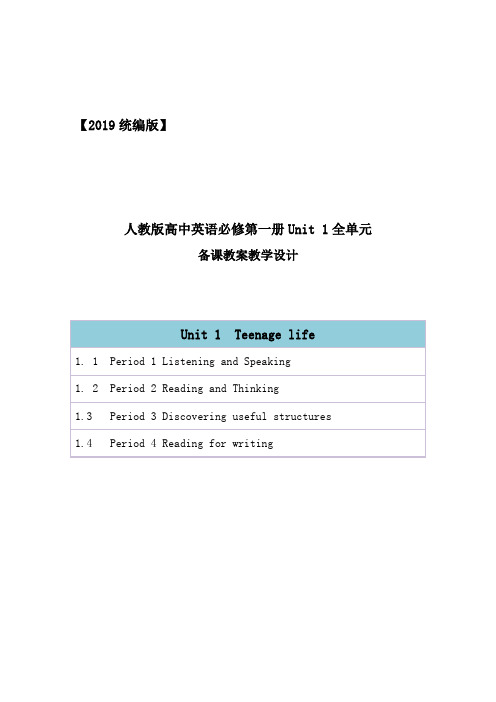
【2019统编版】人教版高中英语必修第一册Unit 1全单元备课教案教学设计1.1 Period 1 Listening and Speaking教学目标与核心素养:1. Let students master the useful words and expressions about school clubs and ways to express their hobbies or interests2. Let students briefly understand functions of different clubs and be aware of the ways of choose a suitable club.3. Get students to practice grasping topics and details while listening a dialogue.4. Get students to talk about topics relating to campus clubs.教学重难点:Importance:1. Get students to practice grasping topics and details while listening a dialogue.2. Get students to talk about topics relating to campus clubs.Difficulty:Guide the students to combine the topic with useful expressions about interests and preferences, and express themselves freely .课前准备:1.Ask the students to make preparations in vocabulary and phrases related to the theme of the period.2.Help the students to finish the Guided Learning Plan教学过程:Step 1Warming upActivity 1Ask Ss to match the photos with the names of the clubs. And hold a brief discussion about what the students are doing in the clubs.Step 2 Listening (1)Activity 2Guide the students to listen to the first two conversations and choose the correct answers.Remind the students to pay attention to the Predict Content:“Before you listen, you can read the questions and choices. It will help you topredict what you will hear.”1.What are they learning about in Conversation 1 ?(A)A. HearingB. SoundsC. Dogs.2.The students are discussing_____ in Conversation 2.(C)A. school workB. relationshipsC. dating.3.Circle the two clubs where these two conversations happened. (A)(D)A. Science ClubB. Ballet ClubC. Nature ClubD. Debate ClubActivity 3Guide the students to listen to conversation3. Then finish the following exercise.1. Tick the activities that happen in each club.Ballet Club Nature Club Cartoon Club Volunteer Clublearn new movements listen to lectures watch cartoons help old peoplewatch dance programs grow plants writes stories clean up parksmake Ballet clothes work in a greenhouse draw cartoons give directions.2. Adams says that he likes ___________but is not so interested in _________ .(B)A. stories, cartoonsB. animals, plantsC. making friends, cleaning up.3. Which club do you think is suitable for Adam? Why?I think Adam should join the Volunteer Club because he likes to do something outdoors.Step 3 SpeakingActivity 4Organize the students to working pairs and help each other choose a school club.Make some preparations before pair work.Brainstorm USEFUL WORDS and EXPRESSIONS FOR THE PAIR WOWRK. Are you going to join …?. I’d like to…, but I am not sure….. Which club do you like to join?. Have you decided which club to join?. My dream is to be……. …is not for me.. I like …,but I am not so interested in….…Provide an example for the students to modify.EXAMPLEA: Hi, Sam! I've decided to join the Music Club.B: Good decision!A: How about you? Are you going to join a club?B: Yes I'm wondering which one I should choose:the Act Club or the Ballet Club?A: I guess the question is… Do you like dancing better than acting?B: Actually, I like acting better, but my friends go to the Ballet Club and I want to be with them.A: Hmm…If you ask me,I think you should choose what you like.Step 5 PronunciationActivity 5Listen and repeat.Guide the students to listen and pay attention to the combinations of lettersEncourage the students to add more words to each groupProvide help whenever necessary.al talk, wall, ball,fall,call, all…ay pay, stay, delay, day, may, play, display, away…ai paint, daily, gain, pain, hailstone, wait…are care, declare, dare, prepare, spare, scare…ar bar, hard, car, star, large, enlarge…er her, prefer, teacher, farmer, paper …ir bird, circus, circle, ,third, thirsty, fir, birthday, shirt, dirty……or horse, absorb, bore, door, story…or word, work…ur burn, hurt, fur, turn, nurse, turtle, purple…ee keen, tree, fee, seem, feet, teeth…ea clean, eager, teach, leave, speak…ea head, ready, bread, weather, sweater, heavy…ear clear, appear, fear, hear, dear, near, ear, …ear earn, heard, search, learn, earn, earth…oa boat, coach, coat, goat, load, …ow show, grow, low, blow, slow, follow, eyebrow……ow now, shower, town, down, how, tower…ou out, loud, about, loud, doubt, mouth, house, mouse…ore more, bored, forecast, forehead, core…2. Guide the students to listen to the proverbs and repeat. Notice the pronunciation of the letters in bold.1. The early bird catches the worm.2. Always prepare for a rainy day.3. Actions speak louder than words.4. All work and no play makes Jack a dull boy.5. Distance tests a horse’s strength. Time reveals a person's character.Period 2 Reading and Thinking教学目标与核心素养:1. Let students master useful words and phrases related to the text;2. Let students understand the challenges Adam meets in his new schooland compare the similarities and differences of their school and Adam’s;3. Help the students finish vocabulary exercises in the text book.4. Get students to understand they should learn to face difficultiesand challenges in senior high school for their own future.教学重难点:Importance:Help the students to master key words and phrases in the text.Guide students to compare school life in different places.3. Guide the students to learn about Adam’s school life and understand that everyone should overcome difficulties in a new situation.Difficulty:Guide the students compare their school life and Adam’s, and discussways to deal with challenges.课前准备:1.Ask the students to prepare new words and phrases related to the contents of the text.2.Mark the new words in the textbook, understand the meaning in context, or consult the dictionary to understand the meaning.教学过程:Step 1 Preparationfreshman ___________ junior high school ___________ Senior high school___________confusing ___________ choose courses___________ signup___________extra-curricular activities___________ hand out ___________ homeless people___________in the community ___________ get used to doing___________ keep upwith ___________challenge _________ topic________ fluent _________ graduate ________recommend ___________ literature_________ obviously_________quit_________be responsible for _________ schedule_________ editor_________Step 2 Warming upCompare school life in different placesActivity 1Guide the students to take part in the group work and discuss schoollife in and out of China.Ask Ss to work in groups and discuss the questions.What do you want to know about the school life in other countries?Possible answers:I want to know whether they take extra courses during summer or winter vocations.I wonder if they have enough free time to develop their own interests.I am interested in what subjects they study at school.…What would you tell a teenager from another country about school lifein China?I am happy to come to my new school and know a lot of new friends.Our teachers are patient and helpful.I feel a little worried about my study because I have more subjectsto learn.…Activity 2Read the text quickly to find the main idea of each paragraph.Guide the students to read the text quickly and fill in the blanks in this part.Possible answers:Paragraph1:Senior high school is a Challenge.Paragraph2:It is important to choose courses.Paragraph3:Extra-curricular activities are also important.Paragraph4:A senior high student must work harder and be more responsible.Step3 Intensive readingActivity 3Read the text again and answer the questions.Guide the students to read the text carefully and find the answers to the following questions.What causes did Adams choose? Which one do you think would be his favorite? Why?What does “make the team” in paragraph mean?What is Adam worried about?Is Adam confident that he will get used to senior school life? How do you know?Possible answers:Adam chooses Math, English chemistry, world history and Chinese. I think. English advanced literature is his favorite because he likes English, and he is good at it.It means joining the football team.He is worried that he can’t keep up with other students in his advanced course and get used to all the homework.Yes, he is. On the one hand, Adam knows that he has to study harderas a senior school student to be well prepared for his future. On the other hand, Adam knows that school advisers and teacher can give him help when he is faced with problems.Activity 4Complete the outline. Then discuss the questions below with a partner.Get the students to work in pairs and fill in the blanks after discussing the questions carefully. Encourage the students to find clues from the text.Guide the students to discuss the following questions and encourage them to answer the questions according to Adam’s story and their own situation.What kind of person do you think Adam is? Why?Do you face the same challenges as Adams? What other challenges areyou facing?What are some differences between Adam’s school and your school life?Possible answers:Adam is clear-minded and responsible for himself. When he chooses courses, he knows his advantages。
新课标高一英语必修一全册教案
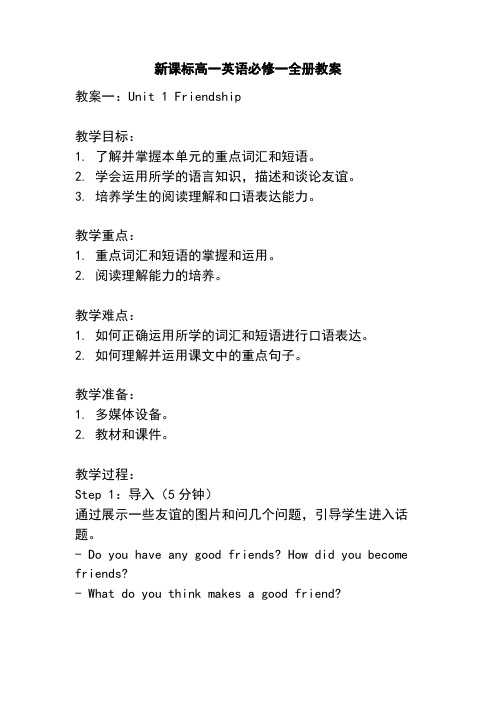
新课标高一英语必修一全册教案教案一:Unit 1 Friendship教学目标:1. 了解并掌握本单元的重点词汇和短语。
2. 学会运用所学的语言知识,描述和谈论友谊。
3. 培养学生的阅读理解和口语表达能力。
教学重点:1. 重点词汇和短语的掌握和运用。
2. 阅读理解能力的培养。
教学难点:1. 如何正确运用所学的词汇和短语进行口语表达。
2. 如何理解并运用课文中的重点句子。
教学准备:1. 多媒体设备。
2. 教材和课件。
教学过程:Step 1:导入(5分钟)通过展示一些友谊的图片和问几个问题,引导学生进入话题。
- Do you have any good friends? How did you become friends?- What do you think makes a good friend?Step 2:词汇和短语学习(10分钟)通过多媒体展示和示范,教授本单元的重点词汇和短语。
- friendship, loyal, trust, support, companion, betray, argue, forgive, appreciate, value, make friends, keep in touch, get along with, fall out with, make upStep 3:阅读理解(20分钟)教师通过多媒体展示,让学生阅读课文,并进行理解。
- 学生阅读课文,并回答一些问题,如:What is the main idea of the passage? What does the author think about friendship? How does the author describe a good friend?Step 4:语言运用(15分钟)通过讨论和练习,让学生运用所学的语言知识进行口语表达。
- 讨论题目:What qualities do you think a good friend should have? Give examples to support your ideas.- 练习:学生分组进行角色扮演,模拟对话中的情景。
新人教版高中英语必修一教学设计
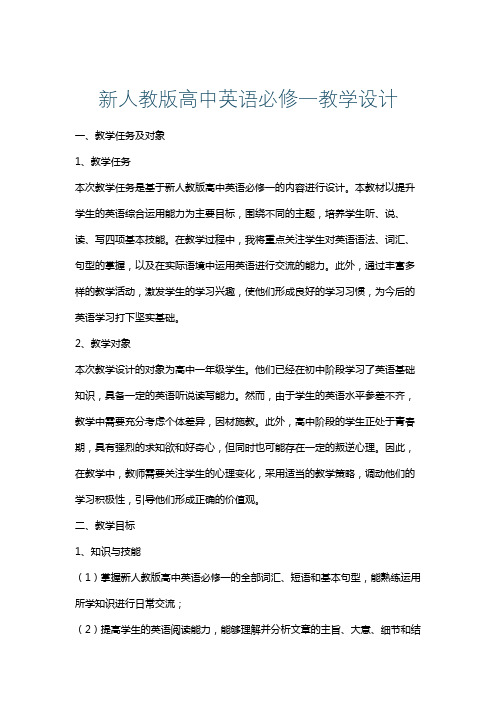
新人教版高中英语必修一教学设计一、教学任务及对象1、教学任务本次教学任务是基于新人教版高中英语必修一的内容进行设计。
本教材以提升学生的英语综合运用能力为主要目标,围绕不同的主题,培养学生听、说、读、写四项基本技能。
在教学过程中,我将重点关注学生对英语语法、词汇、句型的掌握,以及在实际语境中运用英语进行交流的能力。
此外,通过丰富多样的教学活动,激发学生的学习兴趣,使他们形成良好的学习习惯,为今后的英语学习打下坚实基础。
2、教学对象本次教学设计的对象为高中一年级学生。
他们已经在初中阶段学习了英语基础知识,具备一定的英语听说读写能力。
然而,由于学生的英语水平参差不齐,教学中需要充分考虑个体差异,因材施教。
此外,高中阶段的学生正处于青春期,具有强烈的求知欲和好奇心,但同时也可能存在一定的叛逆心理。
因此,在教学中,教师需要关注学生的心理变化,采用适当的教学策略,调动他们的学习积极性,引导他们形成正确的价值观。
二、教学目标1、知识与技能(1)掌握新人教版高中英语必修一的全部词汇、短语和基本句型,能熟练运用所学知识进行日常交流;(2)提高学生的英语阅读能力,能够理解并分析文章的主旨、大意、细节和结构,提高阅读速度;(3)培养学生英语写作能力,能够根据给定的话题进行有逻辑、有条理的写作;(4)提高学生的英语听力水平,能够理解并掌握教材中听力材料的要点,并能进行简单的口头复述;(5)通过口语表达训练,使学生能够自信、流畅地运用英语进行口头表达,增强英语实际运用能力。
2、过程与方法(1)采用任务型教学法,设计丰富多样的教学活动,让学生在实践中学习英语;(2)运用合作学习法,鼓励学生之间相互交流、讨论,共同解决问题,提高学生的团队协作能力;(3)采用启发式教学法,引导学生主动思考,培养学生的自主学习能力和探究精神;(4)注重个体差异,因材施教,针对不同水平的学生制定合适的学习任务和目标;(5)运用多媒体教学手段,创设生动、直观的英语学习情境,激发学生的学习兴趣。
新人教版高中英语必修1教案
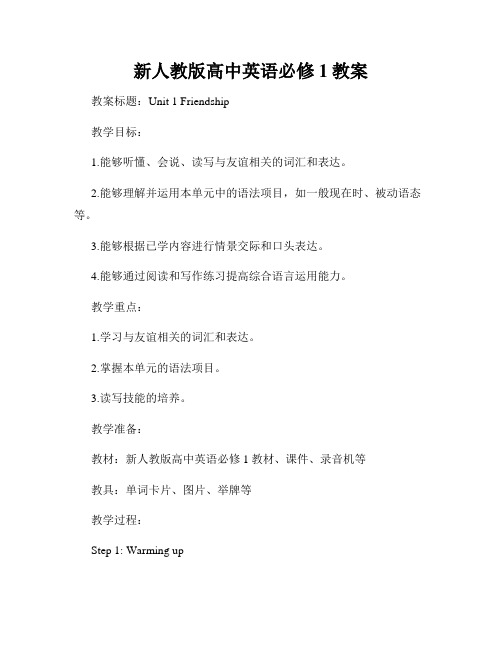
新人教版高中英语必修1教案教案标题:Unit 1 Friendship教学目标:1.能够听懂、会说、读写与友谊相关的词汇和表达。
2.能够理解并运用本单元中的语法项目,如一般现在时、被动语态等。
3.能够根据已学内容进行情景交际和口头表达。
4.能够通过阅读和写作练习提高综合语言运用能力。
教学重点:1.学习与友谊相关的词汇和表达。
2.掌握本单元的语法项目。
3.读写技能的培养。
教学准备:教材:新人教版高中英语必修1教材、课件、录音机等教具:单词卡片、图片、举牌等教学过程:Step 1: Warming up1.通过播放一段关于友谊的视频或展示友谊相关图片来引入本单元话题。
2.鼓励学生谈论友谊的重要性和他们曾经或现在所拥有的朋友。
Step 2: Pre-reading1.引导学生讨论关于"Friendship"的几个问题,如" What qualities make a good friend?" "How do you maintain a friendship?"等。
2.让学生就这些问题进行小组讨论,并共享他们的想法。
Step 3: While-reading1.针对本单元的阅读材料,学生阅读选定的"Reading"部分。
2.师生共同讨论文章中重点词汇和理解难点。
3.进行针对性的问题解答和语言分析。
Step 4: Post-reading1.学生根据所读文章,就相关主题进行小组或全班讨论。
2.组织学生分享他们对于友谊重要性的观点和关于如何维持友谊的方法。
Step 5: Vocabulary Building1.介绍本单元词汇,并鼓励学生使用词汇卡片进行小组活动,以便加深记忆。
2.设计课堂活动,如单词接龙、词义匹配等,加强学生对词汇的记忆与理解。
Step 6: Grammar Focus1.引导学生学习本单元的语法项目,如一般现在时、被动语态等。
人教版新教材英语必修一Unit 1 Teenage Life教案
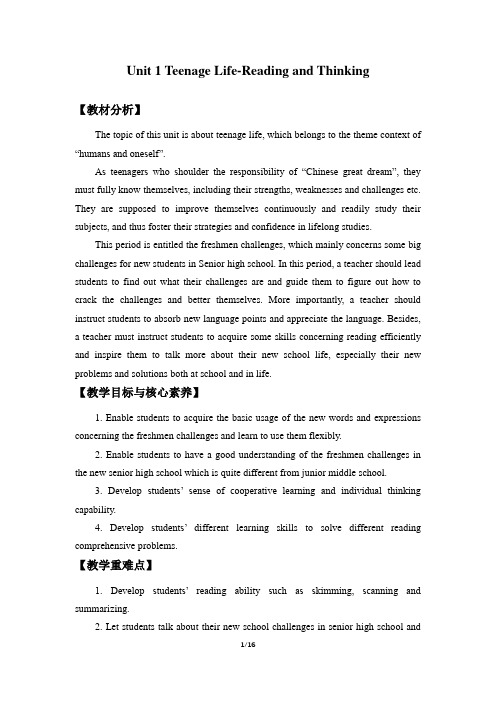
Unit 1 Teenage Life-Reading and Thinking【教材分析】The topic of this unit is about teenage life, which belongs to the theme context of “humans and oneself”.As teenagers who shoulder the responsibility of “Chinese great dream”, they must fully know themselves, including their strengths, weaknesses and challenges etc. They are supposed to improve themselves continuously and readily study their subjects, and thus foster their strategies and confidence in lifelong studies.This period is entitled the freshmen challenges, which mainly concerns some big challenges for new students in Senior high school. In this period, a teacher should lead students to find out what their challenges are and guide them to figure out how to crack the challenges and better themselves. More importantly, a teacher should instruct students to absorb new language points and appreciate the language. Besides, a teacher must instruct students to acquire some skills concerning reading efficiently and inspire them to talk more about their new school life, especially their new problems and solutions both at school and in life.【教学目标与核心素养】1. Enable students to acquire the basic usage of the new words and expressions concerning the freshmen challenges and learn to use them flexibly.2. Enable students to have a good understanding of the freshmen challenges in the new senior high school which is quite different from junior middle school.3. Develop students’ sense of cooperative learning and individual thinking capability.4. Develop students’ diff erent learning skills to solve different reading comprehensive problems.【教学重难点】1. Develop students’ reading ability such as skimming, scanning and summarizing.2. Let students talk about their new school challenges in senior high school andencourage them to find the possible solutions to conquer them.【教学过程】1. Warming upStep 1 Leading-inHave a free talk with students. Ask them the following questions:How do you feel about your senior high school? Have you come across some challenges that make you upset?Step 2 Pre-readingLet students guess what the text will be mainly about before reading by looking at the picture and the title.Step 3 Reading1. Fast readingAsk students to skim the reading passage to sum up the main idea of each paragraph and then discuss it with their partners.Paragraph1.________________________________________________2.________________________________________________3.________________________________________________4.________________________________________________Tips: you can find main ideas by first taking at quick look at the title, picture, key words and phrases and topic sentences.2. Intensive readingAllow students to read carefully this time to understand the main details of each paragraph and then finish the following.1. 1. Adam felt __________at the beginning of his senior highA. excitedB. interestedC. confusedD. worried2. Who gave Adam advice on courses?A. Parents.B. Adviser. C .Coach. D. Classmates.3. What subject is Adam's favorite?A. Chinese.B. World history.C. Math.D. English.4. Hearing he was poor in playing football well, AdamA. felt disappointed but went on with itB. left the football and joined a clubC. didn't give up and tried to improveD. felt unhappy but signed up for a new team5. What kind of person is Adam?A. brave and well preparedB. negative and sillyC. active and shyD. gentle and patient2. Let students look through the chart first and then read the text silently. Three minutes later, check the answers with the whole class. Show the suggested answers onStep 4 Further Reading and discussionRead the text the third time and work in pairs to do the following.1.What does “make the team” in Paragraph 3 mean?2.Do you face the same challenges as Adam? What other challenges areyou facing?3.What are some differences between Adam’s school life and your schoollife?Step 5 Passage ConsolidationComplete the passage with the suitable words from the passage.I'm Adam, 1._______freshman in senior high school. The first week was a little 2. _____ (confuse).There are some 3. _____ (challenge) I have to face in my new school life. First, I had to think carefully about my courses. Chinese is hard to learn, but I hope I can speak it _____ (fluent) when I graduate. My adviser 5. _____ (recommend) me to sign up for advanced literature because I'm good 6. _____it. Second, I had to choose my extra-curricular activities. I tried 7. _____ (join) the school football team though Icouldn't do well in 8. _____at first. Besides that, I joined a volunteer club.In order to be well 9. _____ (prepare) for university or whatever else10. _____ (come) in the future, I make up my mind to study harder and get used to new situation.Step 6 Homework1. Write a passage to introduce you first senior school challenges and how to solve them. (about 120words)2. Learn the useful new words and expressions in this part by heart.Unit 1 Teenage Life-Listening and Speaking & Listening andTalking【教材分析】The theme of “Listening and Speaking” is “Choose a school club”. Students will have a general understanding of different school clubs by listening and ultimately can make reasonable suggestions on the choice of clubs and make correct choices. School clubs are an important part of students’ campus life, as well as an important study to expand students’ extracurricular knowledge, develop their skills and cultivate their interests.Listening text of “Listening and Speaking” consists of two parts. The first part is about the dialogue between teachers and students in the activities of the school clubs, which makes situational preparations for choosing a suitable clubs. The second part is the dialogue between Adam and Julie as senior high school students to discuss how to choose the right one.The theme of “Listening & Talking” is “Plan a camp for teenagers” Nowadays, more and more high school students are interested in participating in various camp activities, and take this opportunity to make friends, broaden their horizons and train their teams’ spiritual and communication skills. The purpose of this section is tostimulate students’ imagination, plan a camp activity that their peers like and to use “be going to+ verb primitive” and “will + verb primitive” to express future intentions or plans.Listening Text of “Listening & Talking” is a dialogue, where Max and Cao Jing talk about their participation in adventure camps and international youth camps on weekends.In the plan, the two men introduced the activities of the camp and expressed their expectations for the life of the camp. The dialogue highlights “be going to + verb” and “will + verb” are two structures used to express what will be done in the future.【教学目标与核心素养】1. Instruct students to get main facts by listening and motivate them to talk about the topics about how to choose a right school club, how to plan a camp for the future, and how to talk about future activities.2. Develop students’ sense of coop erative learning and individual thinking capability.3. Develop students’ different listening skills to solve different listening comprehensive problems.4. Help students to understand how to use the structures “be going to do, will do, plan to do, there will be, hope to do” to discuss their future plans and activities.【教学重难点】Prompt Ss to talk about the related topics, such as how to choose a right school club, how to make a camp for the future, how to make a camp plan and how to talk about future activities.【教学过程】Step 1 Listening and SpeakingLead inThe teacher is advised to talk with their students about school clubs that they were in when they were at junior high school: boys and girls, have you ever taken part in any school clubs before and why you chose them? After the small talk, the teacher can move on by finishing the following listening task:Listen to the first two conversations and choose the correct answers.1. What are they learning about in Conversation 1?A. Hearing.B. Sounds.C. Dogs.2. The students are discussing in Conversation 2.A. schoolworkB. relationshipsC. dating3. Circle the two clubs where these two conversations happened.A. Science ClubB. Ballet ClubC. Nature ClubD. Debate Club.After finishing the task above, the teacher is expected to play Conversation 3 which is about how to help Adam choose a right club and after finishing listening for the first time, the students need to solve the following task.Listen to Conversation 3. Then help Adam choose a club.Tick the activities that happen in each club.Ballet Club○ learn new movements○ make ballet clothes○ watch dance programmesNature Club○ watch biology lectures○ grow plants○ work in a greenhouseCartoon Club○ watch cartoons○ write stories○ draw cartoonsVolunteer Club○ help old people○ clean up parks○ give directionsAfter finishing the task above, the teacher is expected to play Conversation 3 again and solve the following task.1. Adam says that he likes ___________ but is not so interested in___________.2. Which club do you think is suitable for Adam? Why?I think Adam should join the _________Club because he says that he_________.Finally, after finishing the task above, the teacher is expected to instruct students to work in groups to finish the following project:Speaking ProjectWork in pairs. Help each other choose a school club.EXAMPLEA: Hi, Sam! I’ve decide d to join the Music Club.B: Good decision!A: How about you? Are you going to join a club?B: Yes. I’m wondering which one I should choose: the Acting Club or the Ballet Club?A: I guess the question is... Do you like dancing better than acting?B: Actually, I like acting better, but my friends go to the Ballet Club and I want to be with them.A: Hmm ... If you ask me, I think you should choose what you like.Pronunciation part1. Have the Ss listen and repeat, then add more words to each group.2. Then listen to the proverbs and repeat. Have the Ss notice the pronunciation of the letters in bold.Step 2 Listening and Talking1. The teacher is advised to talk with their new students about the related topic: Boys and girls, do you know some structures to talk about future activities?Talking about future activitiesWe’ll …I plan to …There’ll be …I hope to …We’re going to …2. After their small talk, the teacher can move on by playing the listening and solve the following task.Underline the expressions in the sentences below Cao Jing and Max use to talk about the future.We’ll learn useful skills.I plan to improve my spoken English.There’ll be students from different schools.I hope to make new friends.We’ll talk about teenage life.I’ll learn to m ake a fire.There’ll be students from different countries at the camp.There’ll be some experts there to show us how to live in the wild.We’re going to learn about wildlife.I’m going to give a speech.I think I’m going to enjoy the activities.I think we’ll have a lot of fun.3. Work in groups. Plan a youth camp.Teacher make the Ss think of ideas for the camp. And they can use the questions below to get started. And have the Ss present their ideas for a youth camp to the class.●What kind of camp is it?●Who will be there?●What will they do?●What will they learn?EXAMPLE______________campDo you want to have fun and learn at the same time? Then come to our camp. In our camp, you can learn about... There’ll be many interesting activities. First, we are going to... Then we’ll... We also plan to… Finally, we’ll... Please come to our camp!Unit 1 Teenage Life-Discovering Useful Structure【教材分析】This teaching period mainly deals with the grammar: Phrases.This period carries considerable significance to the cultivation of students’ writing competence and lays a solid foundation for the basic appreciation of language beauty. The teacher is expected to enable students to master this period thoroughly and consolidate the knowledge by doing some exercise of good quality.【教学目标与核心素养】1. Get students to have a good understanding of the basic usages of phrases,including adjective phrases, adverb phrases and noun phrases.2. Enable students to use the basic phrases structures flexibly.3. Develop students’ speak ing and cooperating abilities.4. Strengthen students’ great interest in grammar learning.【教学重难点】1. How to enable students to have a good understanding of the basic usages of phrases, including adjective phrases, adverb phrases and noun phrases.2. How to enable students to use the basic usages of phrases flexibly.【教学过程】Step1:语法自主探究读下列例句并感知画线部分的共性。
人教版新教材高中英语第一册教学 Unit 1 XXX第2课时教学设计
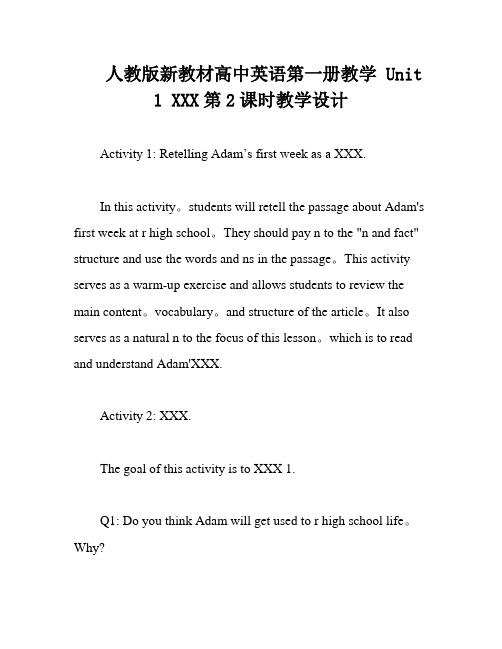
人教版新教材高中英语第一册教学 Unit1 XXX第2课时教学设计Activity 1: Retelling Adam’s first week as a XXX.In this activity。
students will retell the passage about Adam's first week at r high school。
They should pay n to the "n and fact" structure and use the words and ns in the passage。
This activity serves as a warm-up exercise and allows students to review the main content。
vocabulary。
and structure of the article。
It also serves as a natural n to the focus of this lesson。
which is to read and understand Adam'XXX.Activity 2: XXX.The goal of this activity is to XXX 1.Q1: Do you think Adam will get used to r high school life。
Why?XXX。
students will discuss and analyze Adam'XXX。
aswell as his XXX。
This activity will help students develop a positive and XXX.Activity 3: Comparing the campus life of Chinese and foreign freshmen.The goal of this activity is to XXX 2.Students will compare the campus life of Chinese and foreign freshmen。
部编版高一英语教学计划

部编版高一英语教学计划目标本教学计划的目标是帮助高一学生在英语学科中取得进步。
通过结合课堂教学和自主研究等多种教学方法,培养学生的英语听、说、读、写和翻译能力。
教学内容和方法1.听力训练:通过使用录音材料,让学生锻炼听取并理解英语口语的能力。
教师可以准备一些与学生日常生活相关的对话或文章,并帮助学生掌握关键词汇和理解句子结构的方法。
2.口语表达:通过角色扮演、小组讨论等形式,鼓励学生自由表达自己的意见和观点。
教师可以提供一些话题或情景,引导学生进行口语练,并给予及时的反馈和建议。
3.阅读理解:选择一些适合高一学生的英语文章,帮助他们提高阅读理解能力。
教师可以使用一些练题目,让学生通过阅读来获取信息和解答问题。
4.写作训练:从简单的句子起步,逐渐引导学生能够写出完整的段落和文章。
教师可以给予写作指导和写作技巧,并提供一些写作主题和素材供学生练。
5.翻译练:通过将中文翻译成英文或英文翻译成中文的练,帮助学生提高翻译能力。
教师可以选择一些简单的句子或文章,让学生进行翻译,并提供纠正和指导。
教学步骤1.每周备课:教师在每周开始前准备教学内容和练题目,并确保充分了解课本和教学大纲。
2.课堂教学:教师根据教学计划的内容和方法,开展有针对性的教学活动,包括听力练、口语练、阅读理解、写作训练和翻译练。
3.学生练:学生在课后继续进行相关练和研究,巩固所学内容。
教师可以布置一些课后作业,监督学生的研究进度,并及时给予反馈和指导。
4.评估和反馈:教师定期评估学生的研究成果,并及时给予反馈和建议。
教师可以使用一些测验或考试来检查学生的听、说、读、写和翻译能力,并根据评估结果调整教学策略。
教学资源1.教材:使用部编版高一英语教材作为主要教学资源。
2.录音材料:准备一些与教材内容相关的录音材料,用于听力训练。
3.练题目:准备一些关于听、说、读、写和翻译的练题目,帮助学生巩固所学内容。
4.参考书籍:提供一些适合高一学生的英语参考书籍,供学生自主研究使用。
部编版高一英语必修上册教学计划
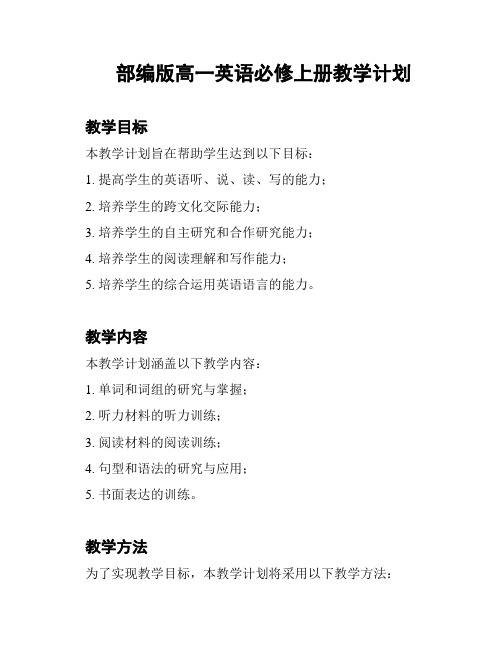
部编版高一英语必修上册教学计划教学目标本教学计划旨在帮助学生达到以下目标:1. 提高学生的英语听、说、读、写的能力;2. 培养学生的跨文化交际能力;3. 培养学生的自主研究和合作研究能力;4. 培养学生的阅读理解和写作能力;5. 培养学生的综合运用英语语言的能力。
教学内容本教学计划涵盖以下教学内容:1. 单词和词组的研究与掌握;2. 听力材料的听力训练;3. 阅读材料的阅读训练;4. 句型和语法的研究与应用;5. 书面表达的训练。
教学方法为了实现教学目标,本教学计划将采用以下教学方法:1. 合作研究:通过小组合作,培养学生的合作精神和团队合作能力;2. 情景教学:通过创设真实情景,激发学生的研究兴趣;3. 任务型教学:通过任务的设计,激发学生的研究动机和研究兴趣;4. 多媒体教学:利用多媒体资源,提供丰富的听力和阅读材料,激发学生的研究兴趣;5. 自主研究:鼓励学生主动参与研究,培养其自主研究的能力;6. 教育游戏:运用游戏化的教学形式,提升学生的参与度和研究效果。
教学步骤本教学计划按照以下步骤进行:1. 导入新知:通过观看图片或视频等导入材料,引起学生兴趣;2. 研究新词汇:通过单词卡片、图片等教具,帮助学生研究和记忆新词汇;3. 听力训练:播放听力材料,鼓励学生听懂并回答相关问题;4. 阅读训练:让学生阅读相关文章或故事,提高其阅读理解能力;5. 句型和语法研究:通过语法教学和实例演练,帮助学生掌握句型和语法知识;6. 书面表达:引导学生进行书面表达练,提高其写作能力;7. 综合训练:进行综合训练,巩固学生所学的知识和技能;8. 总结和反馈:总结本节课的研究内容,给予学生反馈和指导。
教学评估为了评估学生的研究情况和教学效果,本教学计划将采取以下评估方法:1. 日常评价:通过课堂练、口头问答等形式,对学生进行日常评价;2. 作业评价:通过作业的批改和评分,评价学生的研究情况;3. 测验评价:定期进行测验,评估学生的语言能力和知识掌握程度;4. 项目评价:通过项目作业的完成情况,评价学生的合作能力和综合运用能力。
人教版高一英语教学设计

人教版高一英语教学设计Teaching Design:Unit 1 Cultural relicsI. Teaching contentThe course plan is about Unit 1 Cultural relics from People’s Education Press New Senior English Book 1.II. Teaching objectives1. Knowledge objectives:(1) Students will be able to read and understand the text about cultural relics.(2) Students can learn about the impact of tourism on cultural relics and ways of protecting them.2. Ability objectives:(1) Students can train their skills of using the conditional sentence.(2) Students are able to discuss the topic of culture diversification.(3) Students can use the expressions and words related to the topic “cultural relics”.(4) Students can carry out grammatical exercises and writing exercises under the guidance of the teacher.III. Teaching important points1. Understand the text about cultural relics.2. Learn to use the conditional sentence.3. Learn to use the relevant expressions and writing skills.IV. Teaching difficult points1.Master the usage of the conditional sentence.2.Know how to write with the relevant expressions and writing skills.V. Teaching methods(1) Task-based method;(2) Cooperative learning;(3) Discussions to explore.VI. Teaching aidsMultimedia,PPT and blackboard.VII. Teaching procedureStep 1 Lead-in(1) Let the students guess the title of the lesson.(2) Introduce the topic of this lesson and arouse the students’ interest by means of a short video clip and some questions.Step 2 Pre-readingHelp the students to preview the text by giving out some comprehension questions related to the theme of cultural relics.Step 3 While-reading(1) Have the students read the text.(2) Explain and learn the target language points related to the text.(3) Ask the students to do some exercises related to the text.Step 4 Post-readingGive out tasks for the students to do:(1) Imagination tasks.(2) Brainstorming tasks.Step 5 Sum upHelp the students review the knowledge they have learnt in this lesson.Step 6 HomeworkAsk students to search applicable news and write an essay based on the knowledge they have learnt.。
- 1、下载文档前请自行甄别文档内容的完整性,平台不提供额外的编辑、内容补充、找答案等附加服务。
- 2、"仅部分预览"的文档,不可在线预览部分如存在完整性等问题,可反馈申请退款(可完整预览的文档不适用该条件!)。
- 3、如文档侵犯您的权益,请联系客服反馈,我们会尽快为您处理(人工客服工作时间:9:00-18:30)。
教师学科教案[ 20 – 20 学年度第__学期]任教学科:_____________任教年级:_____________任教老师:_____________xx市实验学校Unit 1 Friendship(1) 课题:Friendship (2) 教材分析与学生分析:本单元的中心话题是“友谊”,几乎所有的内容都是围绕这一中心话题展开的。
Warming Up部分以调查问卷的形式引导学生了解日常生活中朋友之间发生的真实问题以及解决这些问题的方法;Pre-Reading部分的几个问题启发学生对“友谊”和“朋友”进行思考,使学生明确不仅人与人之间可以做朋友,日记也可以成为人们的朋友;Reading部分Anne’s Best Friend以日记形式讲述了犹太女孩安妮的故事;Comprehending部分通过连句、多项选择和问答形式帮助学生对课文内容、细节进行更深入的理解; Using about Language 部分教学本课重点词汇和重点语法项目。
(3) 课时安排:The first period: Speaking: Warming Up andPre-Reading The second period:ReadingThe third period: GrammarThe forth Period:ListeningThe fifth period: Writing(4)教学目标:①知识与技能:Talk about friends and friendship; Practise talking about agreement and disagreement, giving advice and making decisions; Use direct speech and indirect speech; Learn to write an essay to express and support an opinion.②过程与方法:本单元在读前阶段就提出问题,让学生思考是不是只有人与人之间才能交朋友,然后在阅读中通过安妮的日记向学生说明我们也可以与动物及无生命的日记交朋友。
在深刻理解、充分训练的基础上,可以再引导学生深入讨论几个与本单元话题有关的问题:1.描述朋友; 2. 结交网友;3. 观点交流;4. 善\不善交朋友; 5. 朋友的重要性。
③情感态度与价值观:学完本单元后要求学生进行自我评价,主要评价自己在本单元中的学习情况。
对书中的内容是否感兴趣,有哪些收获,解决了什么问题。
使学生加深对友谊、友情的理解,以及如何正确交友,处理朋友之间发生的问题等。
(5) 教学重点和难点:词汇:add point upset ignore calm concern cheatshare reason list series crazy nature purpose dare thunderentirely power according trust sufferadvice situation communicate habit短语:add up calm down have got to be concerned about go through hide away set down on purpose in order to face toface according to get along with fall in love join in重点语法项目:直接引语和间接引语的互相转换难点:Understand the real meaning of friends and friendship;Discuss the answers to the questions (Reading);How to teach the Ss to master the usage of Direct Speech and Indirect Speech(Statement and Questions).(6) 教学策略:Discussion, Student-centered vocabulary, learning, listening, pair work, teach grammar in real situation (7) 教学煤体设计:A projector and a tape recorder. (8) 教学过程:详见以下分课时教学设计。
(9) 课堂练习与课外作业设计:穿插于分课时教学设计中(10)教学反思或值得改进的地方:见每个课时最后部分。
Period One:Speaking (Warming Up and Pre-Reading)AimsTalk about friends and friendship.Practise talking about agreement and disagreement.Step I RevisionAsk some of the students to read his / her composition for the class, describing one of the problems between friends and how it is solved. Then give some comments.T: Now, let's check up your homework for last class. I'd like some of you to read his / her composition for the class, describe one of the problems between friends and how it is solved.Step II Warming upT: / think most of us have some good friends. Do you know why people make friends with one another?Step III Talking(WB P41)First get the students to listen to what a Canadian say about making friends. Then ask them to discuss the two questions.T: Now we're going to listen to what Leslie Clark, a Canadian has got to say about making friends. After listening, please talk about the two questions in groups of 4. Try to use the following expressions.1 Do you agree with her? 找教案2 What do you think of people from foreign countries?Agreement DisagreementI think so, I don't think so.I agree. I don't agreeThat's correct. Of course not.That's exactly my opinion. I'm afraid not.You're quite right. I don't think you are right.Step IV Speaking(B P6)First, get the students to think of four situations among friends in groups of 4 and design a questionnaire to find out what kind of friends their classmates are. Second, try it out on their own group, checking the questionnaire through and adding up their score and see how many points they can get. Ask them to fill in the form prepared before class. Show the instructions and decide what kind of friends their classmates are. Third, ask each student to stand up and walk around the classroom to make a survey on four of other classmates. Show the instructions and decide what kind of friends other classmates are. They can share your questionnaire with one or two other groups and try each other's questionnaires.At last, show the instructions to help your classmates to know how to improve his or her skills of making good friends with others if necessary.T: Friends come in many flavors. There are best friends, school friends,fair-weather friends, forever friends and many more. Do you want to know what kind of friends your classmates are? Now let's make a survey. First, please think of four situations among friends and design a questionnaire to find out what kind of friends your classmates are.1. Your friend borrowed 100 Yuan from you last week and hasn't returned it. You willA. ask him / her to pay back as soon as possible; or you'll end the friendship.B. ask him / her to pay back if he / she has.C. tell him / her not to return it.2. Your friend said your bad words behind you. You willA. ask him / her to say sorry to you , or you'll stop your friendship.B. excuse him / her and forget it.C. ask others to tell him / her that he/she is wrong.3. You promised to meet your friend at five o'clock but your parents ask you to do homework at home. You willA. tell him your parents ask you to do homework at home.B. tell him / her a lie that you are ill.C. say sorry to him / her and plan to meet him / her another time.4. You borrowed a bike from your friend, but you had it stolen. You willA. buy a new one which is the same as his / hers.B. just tell him / her you had it stolen.C. say sorry to him/her and buy him/her an old oneAfter they finish choosing the answers, show the scoring sheet on the screen.Scoring s heet1AO B2C6 2 Al B6C23A2BO C3 4 A6B l C2Instructions:2-5 A fair-weather friend 找教案Only like them when they are happy and popular. If they are feeling down, or if they are having a problem, you don't want to spend time or talk with them. You don't help your friends when they have problems. You are always thinking about yourself.You should care more about your friends. If you continue to be self-centered and don't consider others' feelings, you won't make more friends and keep friendship for long.6-11 A school friendYou see each other in school. You just study and play with them together in school. You may not know everything about each other. You take things smoothly. You seldom hurt your friends with your benefit considered. You'd better add more affection to your friends. Friendship is about feelings and we must give as much as we take.12-17 A best friendYou do everything together with your friends: study, read, watch TV, surf the Internet, play sports and listen to music. If either one has a problem, the other is there to help. You know your friends very well. You understand and yield to each other. You help with each other and improve together. You have a lot of common benefit. Your friendship is good to both of you. You are mutually beneficial.18-21 Forever friendYou will always listen to your friends and try to help them, even if you disagree or if you are having a problem. Whenever they have any difficulty, you'll try your best to do what you can to help them without hesitation. You devote yourself to your best friends. You are willing to lose what you have, even your life.课后反思:本课教学设计容量和密度较大,但难度适中,大部分学生都能接受。
